Gemma Day’s skin ended up addicted to the steroid cream she’d used to treat her extreme eczema – prompting a horrifying reaction.
Plagued by extreme eczema, an office administrator relived her horror when she woke a week before her wedding with her eyes swollen shut – later discovering her skin was addicted to steroid cream.
Click to Gallery
Gemma Day’s skin ended up addicted to the steroid cream she’d used to treat her extreme eczema – prompting a horrifying reaction.
When Gemma Day ditched the ointment – known to thin the skin – which she had started using as a teenager to temper her angry condition, the withdrawals were even worse than the eczema.
“Eczema dictates all the big events in my life, which doesn’t seem fair. I can’t even wear make-up. I’ve only used it 10 times in the past five years, but did manage to wear it on my wedding day.
“What had been small patches of dry skin started to spread across my body and slowly, over the years, it covered almost every patch of skin, covering my entire body,” Gemma said.
But she found that as soon as she stopped using the creams, her skin went into what she later discovered was topical steroid withdrawal – leaving it dry, red and burning, with the redness spreading even more.
“I woke up and couldn’t open my eyes because they were so swollen,” she said.
“Autumn is the best time of year for my eczema, so there was no question – we would be getting married in the Australian Autumn season, which is March to May,” she explained.

Gemma and husband Brenton on their wedding day (PA Real Life/Collect)
When Gemma Day ditched the ointment – known to thin the skin – which she had started using as a teenager to temper her angry condition, the withdrawals were even worse than the eczema.
And, just seven days before tying the knot with her lawyer fiancé Brenton Day, 25, on April 14 this year, the effects were so extreme she could not open her eyes and was forced to have another steroid “fix.”
Gemma, 24, of Toowoomba, Queensland, Australia, said: “I had to cave in and use more steroid cream to calm everything down before my wedding.

Gemma and husband Brenton on their wedding day (PA Real Life/Collect)
“Eczema dictates all the big events in my life, which doesn’t seem fair. I can’t even wear make-up. I’ve only used it 10 times in the past five years, but did manage to wear it on my wedding day.
“I even asked my boss if I could work somewhere where no one could see me, because I feel like a monster when my eczema is red-raw and cracked, at its worst.”
Born with eczema – a condition causing the skin to become itchy, raw, red, dry and cracked – Gemma had it under control as a young child, but when she hit 13, things changed.
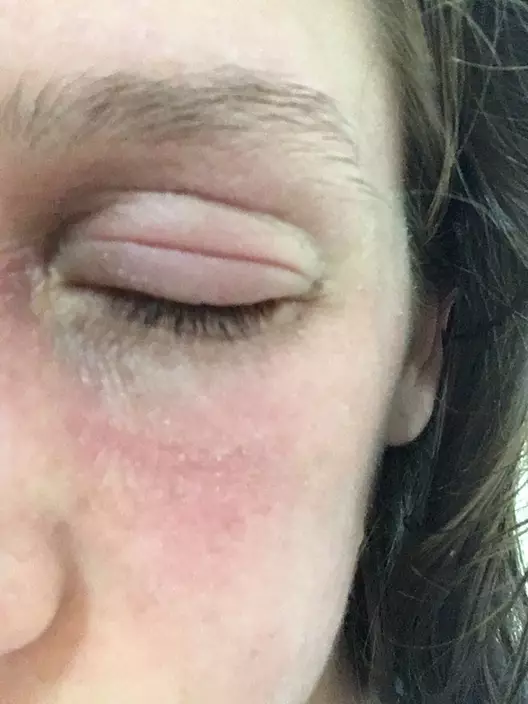
Gemma woke a week before her wedding with her eyes swollen shut, pictured (PA Real Life/Collect)
“What had been small patches of dry skin started to spread across my body and slowly, over the years, it covered almost every patch of skin, covering my entire body,” Gemma said.
“Now only my feet, a small part of my chest and my palms are clear, but the rest of me is coated. Sometimes I feel like a monster. I try to keep as much of my skin covered as I can, but it’s hard to cover my face when I have a job to do.”
After visiting her doctor in her teens – who suspected her condition had worsened because of school stress – Gemma was prescribed steroid cream to help ease her discomfort.
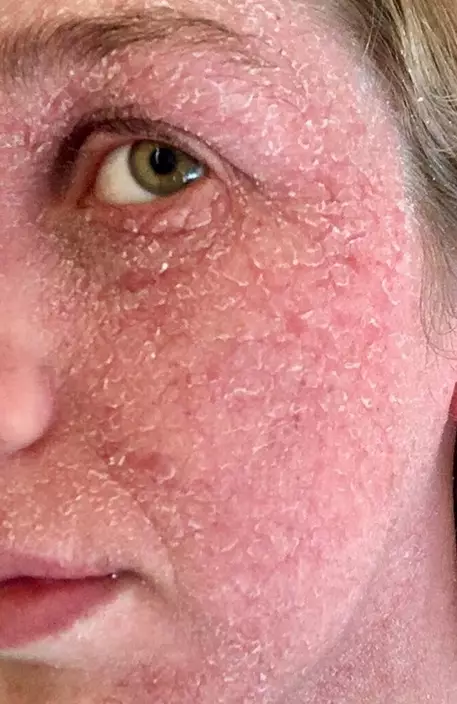
Gemma's skin was addicted to steroid cream. (PA Real Life/Collect)
But she found that as soon as she stopped using the creams, her skin went into what she later discovered was topical steroid withdrawal – leaving it dry, red and burning, with the redness spreading even more.
“After using the cream so much over the years, unwittingly I became addicted,” she said. “I’d get flare-ups of sore and cracked skin every time I tried to wean myself off the steroid creams.”
And a week before her wedding at the Japanese Gardens in Toowoomba, her withdrawals were so extreme she could not open her eyes and had to go back to using the steroids in order to function.

Gemma is plagued by extreme eczema (PA Real Life/Collect)
“I woke up and couldn’t open my eyes because they were so swollen,” she said.
“It’s a common side effect of withdrawal from steroid creams and I was freaking out. With my hen do the next day and my big day not long after, I was devastated to think everything could be ruined.”
Visiting her GP, Gemma was given steroids creams again, just to get her through her wedding and honeymoon to the UK.
Even before this happened, she had planned her big day around her eczema.
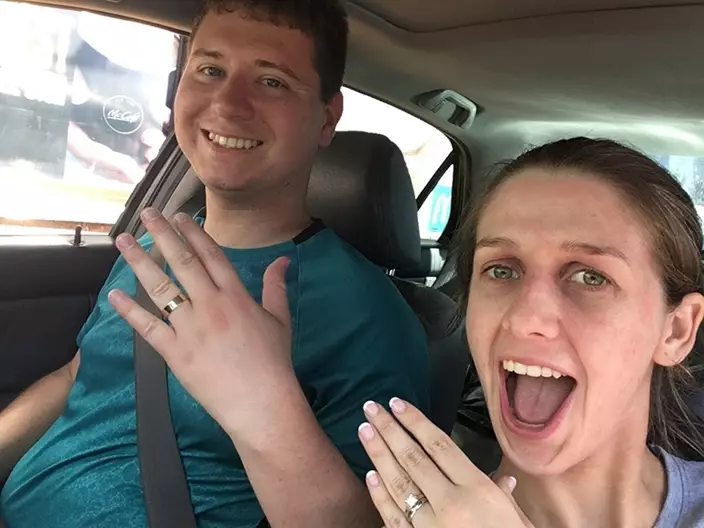
Gemma and husband Brenton (PA Real Life/Collect)
“Autumn is the best time of year for my eczema, so there was no question – we would be getting married in the Australian Autumn season, which is March to May,” she explained.
She added: “We picked April, but then there was the question of my wedding dress. I had always suffered with the eczema on my arms, so knew I could never choose a short-sleeved wedding dress and opted for a long-sleeved one.”
When the pair, who met online, finally tied the knot on April 14, Gemma says it was the best day of her life, but regrets the hold her eczema had over her.
Hospitalised with eczema only last week, she has now given up the steroid cream, but has to moisturise four times a day, drink at least three litres of water and most importantly – try not to scratch.
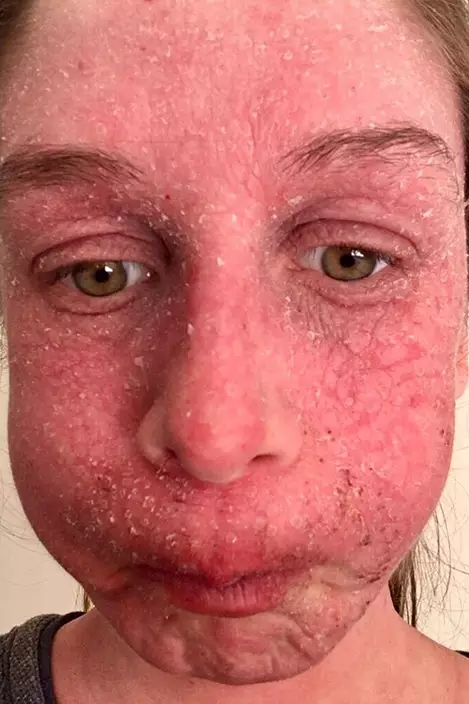
Gemma says her ezema dictates all the big events in her life(PA Real Life/Collect)
She said: “It was only after my wedding that I realised I had been addicted to steroid cream because of how much my skin flared up when I wasn’t using the treatment.
“Now, I want other people with eczema to know they are not alone and hope that sharing my story will help them.”
DALLAS (AP) — Millions of people along a narrow band in North America will look up when the sky darkens during a total solar eclipse on April 8. When they do, safety is key.
Staring directly at the sun during a solar eclipse or at any other time can lead to permanent eye damage. The eclipse is only safe to witness with the naked eye during totality, or the period of total darkness when the moon completely covers the sun.
Those eager to experience the eclipse should buy eclipse glasses from a reputable vendor. Sunglasses are not protective enough, and binoculars and telescopes without a proper solar filter can magnify light from the sun, making them unsafe.
“Please, please put those glasses on,” NASA Administrator Bill Nelson said.
Since counterfeit glasses abound, consider purchasing glasses from a local science museum or order online from a seller cleared on the American Astronomical Society’s website.
Eclipse safety experts say legitimate eclipse glasses should block out ultraviolet light from the sun and nearly all visible light. When worn indoors, only very bright lights should be faintly visible – not household furniture or wallpaper.

This microscope image provided by Mount Sinai’s New York Eye and Ear Infirmary shows damage to the retina of a person who viewed the 2017 eclipse without adequate protection, and a drawing by the patient showing the shape of what the visual artifact looks like to her. She complained of a black spot in her vision, and doctors discovered retinal damage that corresponded to the eclipse’s shape. (New York Eye and Ear Infirmary of Mount Sinai, JAMA via AP)
Old eclipse glasses from the 2017 total solar eclipse or October's “ring of fire” annular eclipse are safe to reuse, as long as they aren't warped and don't have scratches or holes.
Glasses should say they comply with ISO 12312-2 standards, though fake suppliers can also print this language on their products. NASA does not approve or certify eclipse glasses.
If you don't have eclipse glasses, you can still enjoy the spectacle through indirect ways such as making a pinhole projector using household materials.
Poke a hole through a piece of cardstock or cardboard, hold it up during the eclipse and look down to see a partial crescent projected below. Holding up a colander or a cracker will produce a similar effect.
Another trick: Peering at the ground under a shady tree can yield crescent shadows as the sunlight filters through branches and leaves.
Eye experts warn against viewing the eclipse through a phone camera. The sun’s bright rays can also damage a phone’s digital components.
Eye damage can occur without proper protection. The sun's bright rays can burn cells in the retina at the back of the eye. The retina doesn’t have pain receptors, so there’s no way to feel the damage as it happens. Once the cells die, they don’t come back.

This microscope image provided by Mount Sinai’s New York Eye and Ear Infirmary shows damage to the retina of a person who viewed the 2017 eclipse without adequate protection. She complained of a black spot in her vision, and doctors discovered retinal damage that corresponded to the eclipse’s shape. (New York Eye and Ear Infirmary of Mount Sinai, JAMA via AP)
Symptoms of solar eye damage, called solar retinopathy, include blurred vision and color distortion.
In a rare case of eclipse eye damage, a woman who viewed the 2017 eclipse without adequate protection came to Mount Sinai’s New York Eye and Ear Infirmary, complaining of a black spot in her vision. Doctors discovered retinal damage that corresponded to the eclipse’s shape.
“The dark spot she was describing was in the shape of a crescent,” said Dr. Avnish Deobhakta, a Mount Sinai ophthalmologist.
There’s no set rule for how long of a glance can lead to permanent damage. Severity varies based on cloudiness, air pollution and a person's vantage point.
But doctors say looking at a solar eclipse for even a few seconds unprotected isn’t worth the risk. There are reports of solar retinopathy after every solar eclipse, and U.S. eye doctors saw dozens of extra visits after the one in 2017.
Spectators who plan ahead can secure a stress-free eclipse viewing experience.
“It can be dangerous if we aren’t careful, but it’s also very safe if we take the basic precautions,” said Dr. Geoffrey Emerson, a board member of the American Society of Retina Specialists.
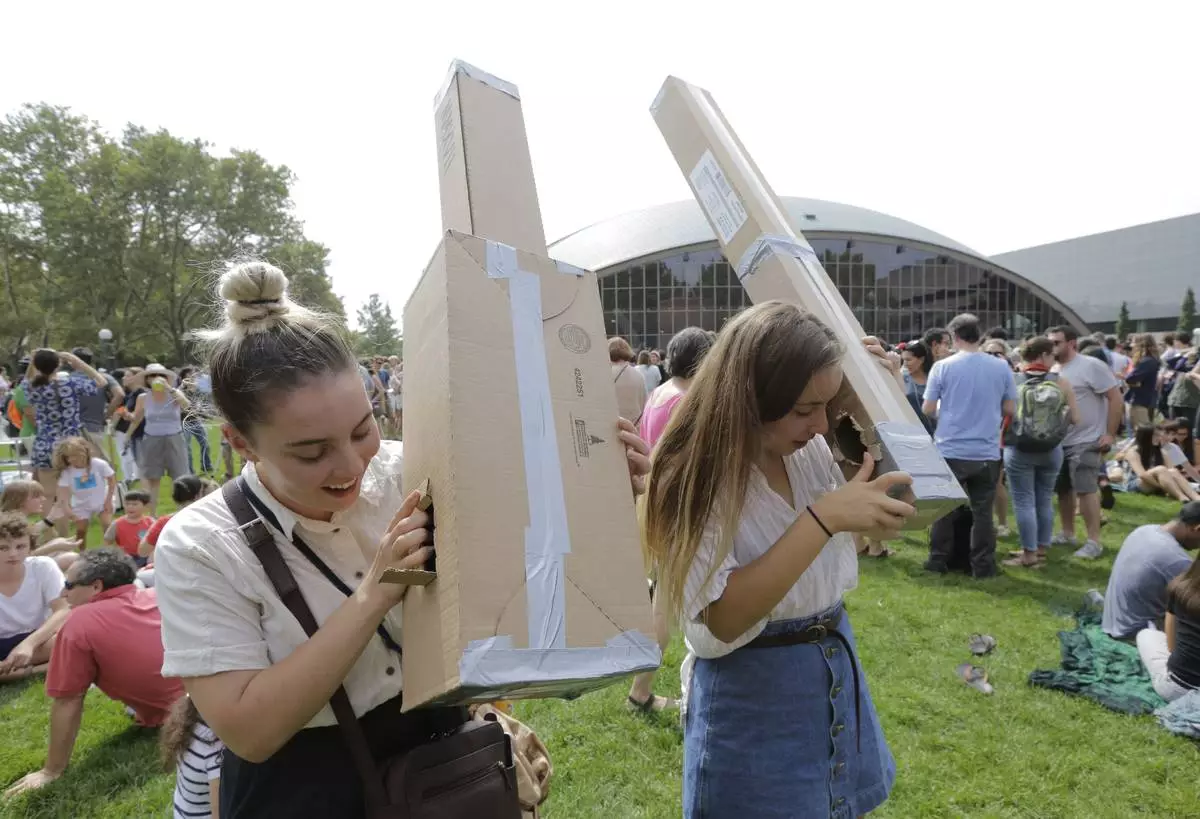
FILE - Reveka Pasternak, of Boston, left, and her sister Tristen, of Philadelphia, right, use pinhole projectors to view a partial solar eclipse, Monday, Aug. 21, 2017, on the campus of Massachusetts Institute of Technology, in Cambridge, Mass. The sisters made the pinhole projectors from cardboard that allow people to safely view the eclipse. (AP Photo/Steven Senne, File)
The Associated Press Health and Science Department receives support from the Howard Hughes Medical Institute’s Science and Educational Media Group. The AP is solely responsible for all content.
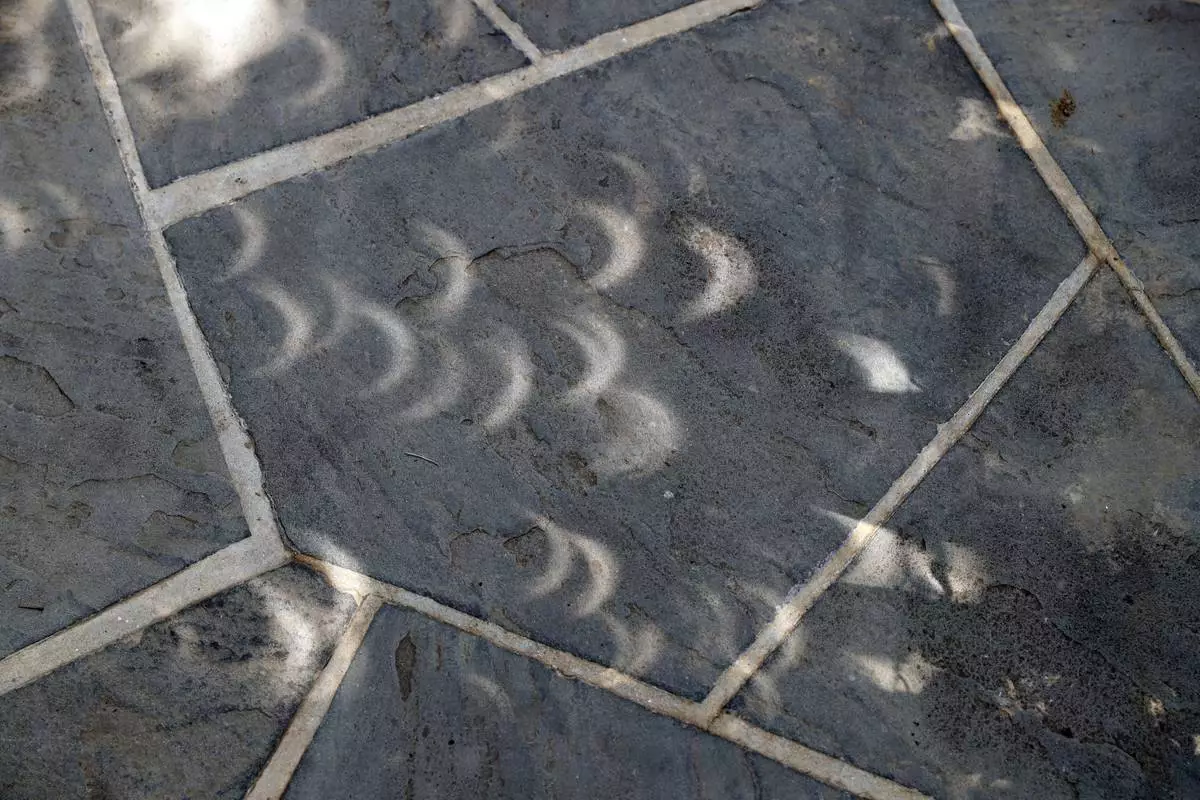
FILE - Projected images of the eclipse are seen through the leaves on the trees on the sidewalk at the White House in Washington, Monday, Aug. 21, 2017. (AP Photo/Alex Brandon, File)
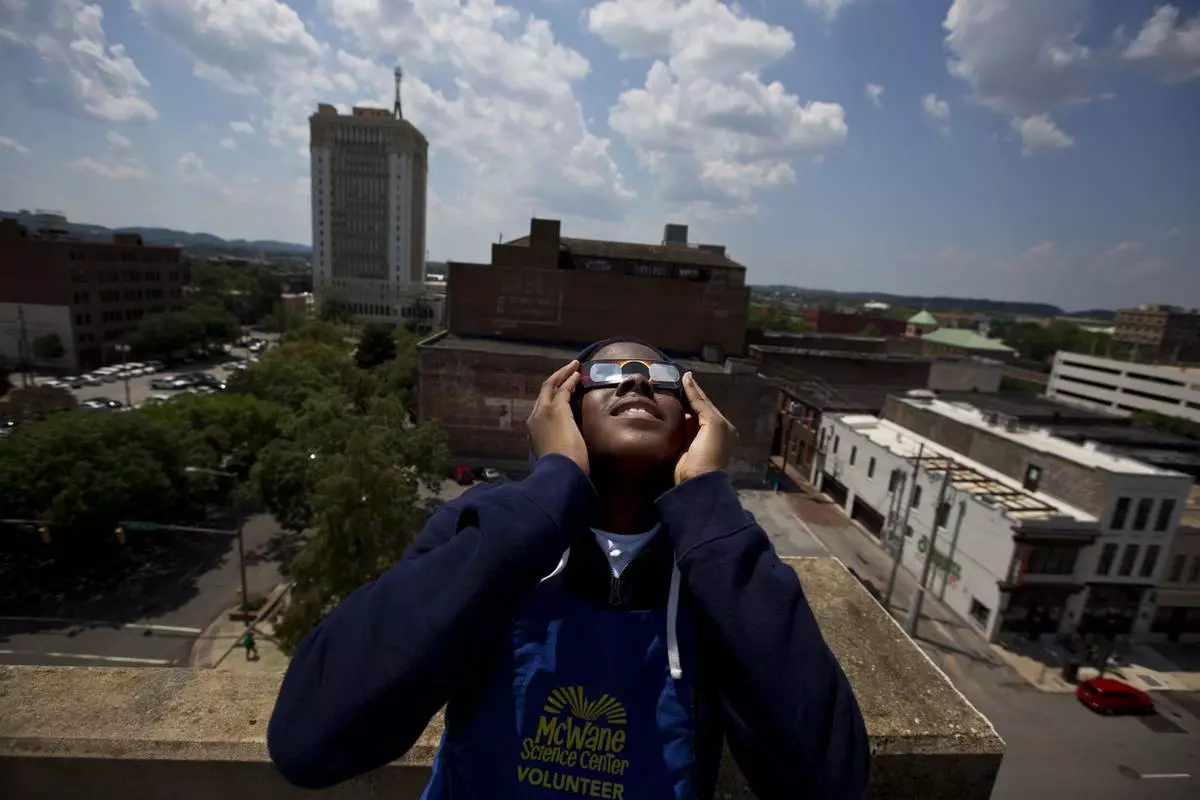
FILE - Justin Coleman, of Birmingham, Ala., holds his glasses up to his eyes as he watches the solar eclipse atop a parking structure, Monday, Aug. 21, 2017, in Birmingham. Safe solar eclipse glasses block out the sun’s ultraviolet rays and nearly all visible light. When worn indoors, only very bright lights should be faintly visible – not household furniture or wallpaper. (AP Photo/Brynn Anderson, File)














